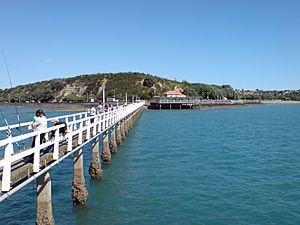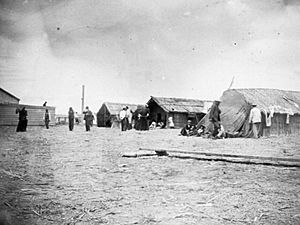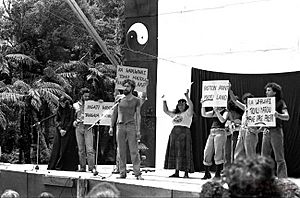Bastion Point facts for kids
Bastion Point (also known as Māori: Kohimarama or Takaparawhā) is a special piece of land in Orakei, Auckland, New Zealand. It sits right by the sea, looking over the Waitematā Harbour. This area is very important in New Zealand's history. In the late 1970s, it was the site of big protests by Māori against their land being taken by pākehā (European settlers).
Contents
History of Bastion Point
Early Māori Life
Long ago, before New Zealand was settled by Europeans, Bastion Point was a very important place for the Ngāti Whātua people. This iwi (tribe) lived on this land. It was a great spot because it overlooked areas rich in fish and good for farming.
Government Takes Land
Over many years, from the 1840s to the 1950s, the New Zealand Government took over the land around Bastion Point. They said they needed it for "public works," which means building things for everyone, like roads or buildings. This process is called land alienation, where land is taken from its original owners.
The Bastion Point Protest
Why the Protest Started
In 1885, the government built a military base at Bastion Point. They chose this spot because it had a great view of the Waitematā Harbour, making it good for defence. In 1886, the government used a law to officially take 13 acres (about 5 hectares) of Bastion Point for this military purpose.
By 1941, the government no longer needed Bastion Point for defence. But instead of giving the land back to the Māori owners, they gave it to the Auckland City Council. It was meant to be a public park. This was the last piece of land (about 60 acres or 24 hectares) in Orakei that the hapū (sub-tribe) Ngāti Whātua-o-Ōrākei hoped to get back.
Then, in 1976, the government announced a new plan. They wanted to sell Bastion Point to the highest bidder. The idea was to build expensive houses there.
The Occupation Begins
Joe Hawke, who was a leader from the hapū, and other activists were very upset. They formed the Orakei Māori Action Committee. They decided to take "direct action" to stop the land from being sold.
In 1977, just two days before building was set to start, the Orakei Māori Action Committee began an occupation of the land. This meant they stayed on the land to stop the government from taking it. The people built a marae (a meeting place) and temporary homes. They even started growing crops. Sadly, on September 26, 1977, a fire in a tent caused the death of a young girl named Joanna Hawke, who was Joe Hawke's niece.
The Protest Ends
The occupation at Bastion Point lasted for 506 days. It finally ended on May 25, 1978. On that day, 800 police officers and soldiers from the New Zealand Army came to the site. They forcibly removed the protesters and destroyed all the temporary buildings, including the gardens and the marae. Two hundred and twenty-two protesters were arrested.
What Happened Next?
The occupation and the way it ended were very important. They helped show people the unfair things that had happened to Māori. The protest became a major moment in the history of the Māori protest movement.
In the 1980s, the New Zealand Government returned the land to Ngāti Whātua. They also paid compensation as part of a Treaty of Waitangi settlement. This was a way to try and fix past wrongs.
In 1980, filmmakers Merata Mita, Leon Narbey, and Gerd Pohlmann made a documentary called Bastion Point Day 507. It supported the protest and showed what happened when Māori land was taken.
Michael Joseph Savage Memorial
Bastion Point is also home to the Savage Memorial. This memorial honours Michael Joseph Savage (1872–1940), who was the first Labour Prime Minister of New Zealand.
Images for kids






